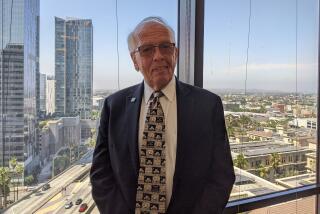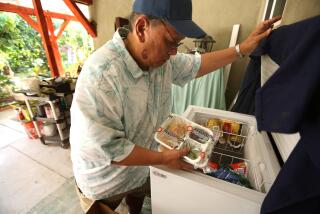An Rx for a Fiscally Anemic Clinic
- Share via
In Friday morning’s sunshine, 90-year-old Fred Gilbert was busy outside the Laguna Beach Community Clinic, sweeping leaves and cigarette butts into a shovel and tossing the debris into a trash barrel.
Gilbert typically would be fixing “doors that don’t close and locks that don’t work” but said he decided to switch gears.
“I’m cleaning up because it looks messy,” the Laguna Beach resident explained. “We have no one else to do it.”
Six months after UCI Medical Center pulled the plug on this aging community clinic, its heart is still beating steadily, thanks in large part to the many volunteers who have refused to let it die.
While services have been trimmed to save money and the counseling program eliminated altogether, unpaid workers have donated hundreds of hours a month while directors keep searching for Orange County health care agencies that might form a partnership with the clinic.
Retired nurse Helen Georges, 62, who helps out in the pharmacy, said she is “extremely confident” that the 27-year-old center at 362 3rd St. will survive.
The clinic provides dental care and a wide variety of basic medical services, such as family planning, prenatal care, immunizations and tuberculosis tests. Patients pay based on a sliding scale geared to their income. HIV testing is free.
Residents at nearby Hagan Place, an apartment building for low-income persons with AIDS, depend on the clinic, apartment manager Larry Manning said.
“For some of our residents, it is really convenient and a nice safety net to know they are there across the street,” he said. “A lot of times . . . HIV people can take a turn physically quite suddenly. The fact that they’re there for us is quite wonderful.”
Citing financial pressures, UCI Medical Center officials announced in May 1996 that they would close the clinic by July.
“The board of directors, at that point in time, set as our goal that the clinic was not going to close,” said Gwen Barry, president of the clinic’s directors. “The commitment was that there would not be a gap in the services.”
Clinic directors renegotiated service contracts, worked to maintain government grants, made sure the clinic was adequately staffed and hired a new executive director. At the peak of the crisis, Barry said, she was volunteering 30 hours a week.
Meanwhile, clinic workers launched a “Cure the Clinic” campaign, and donations flowed in from the community.
Though the patient load has been trimmed by about 30% and patients must wait up to two weeks for some services, volunteers said, the clinic is surviving.
Volunteer Georges said the community stands firmly behind that campaign. “The clinic’s very important,” she said. “I’d hate to see it go down.”
More to Read
Sign up for Essential California
The most important California stories and recommendations in your inbox every morning.
You may occasionally receive promotional content from the Los Angeles Times.










